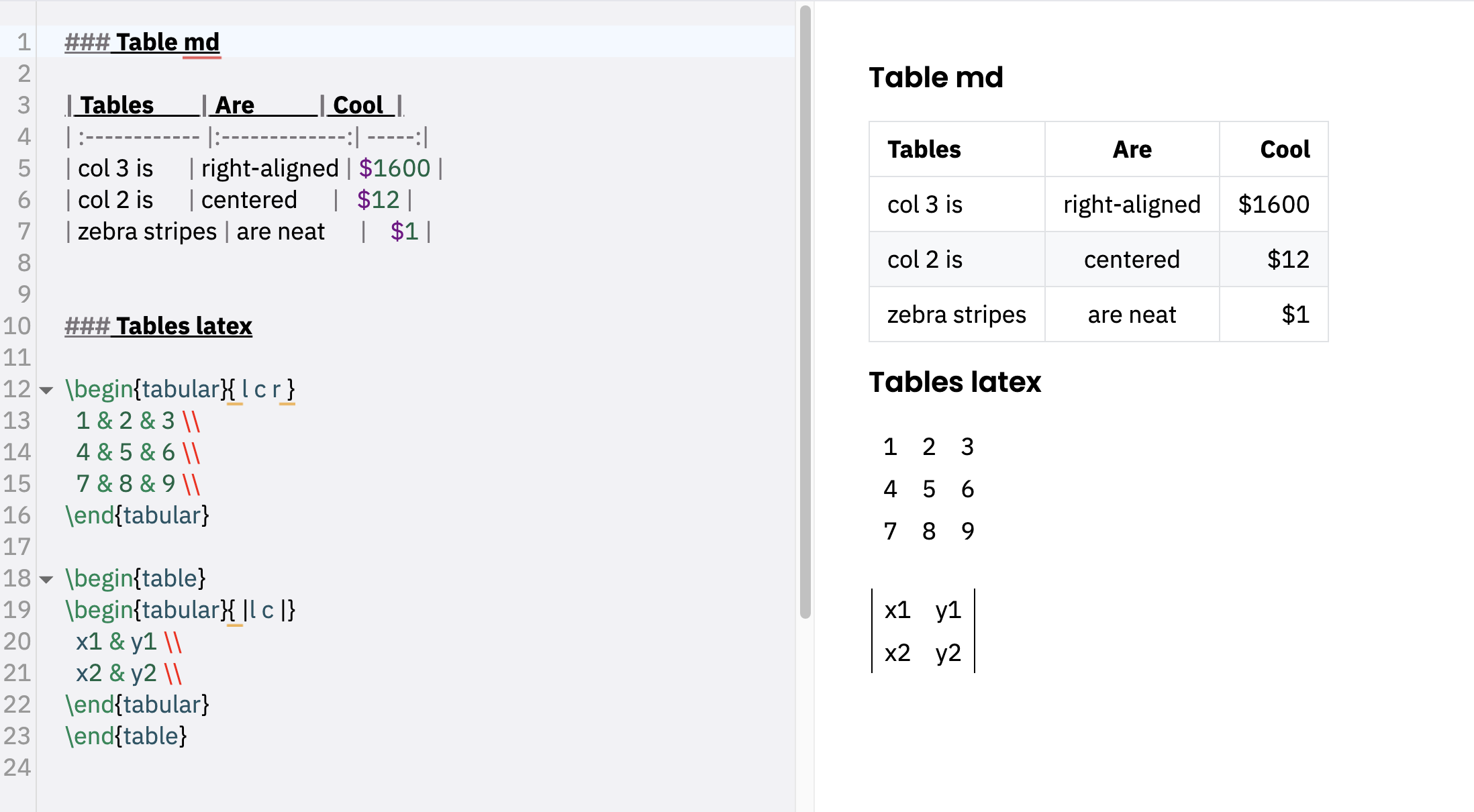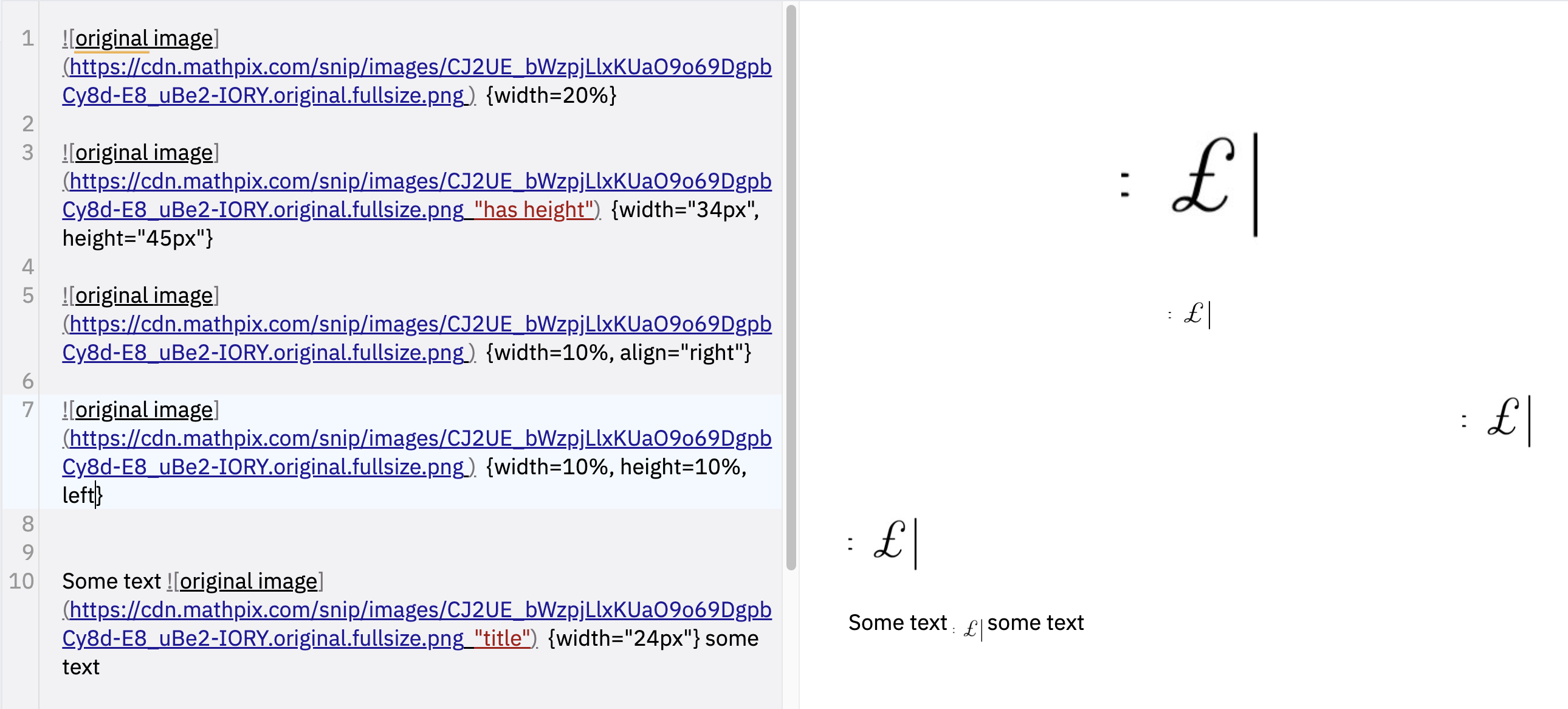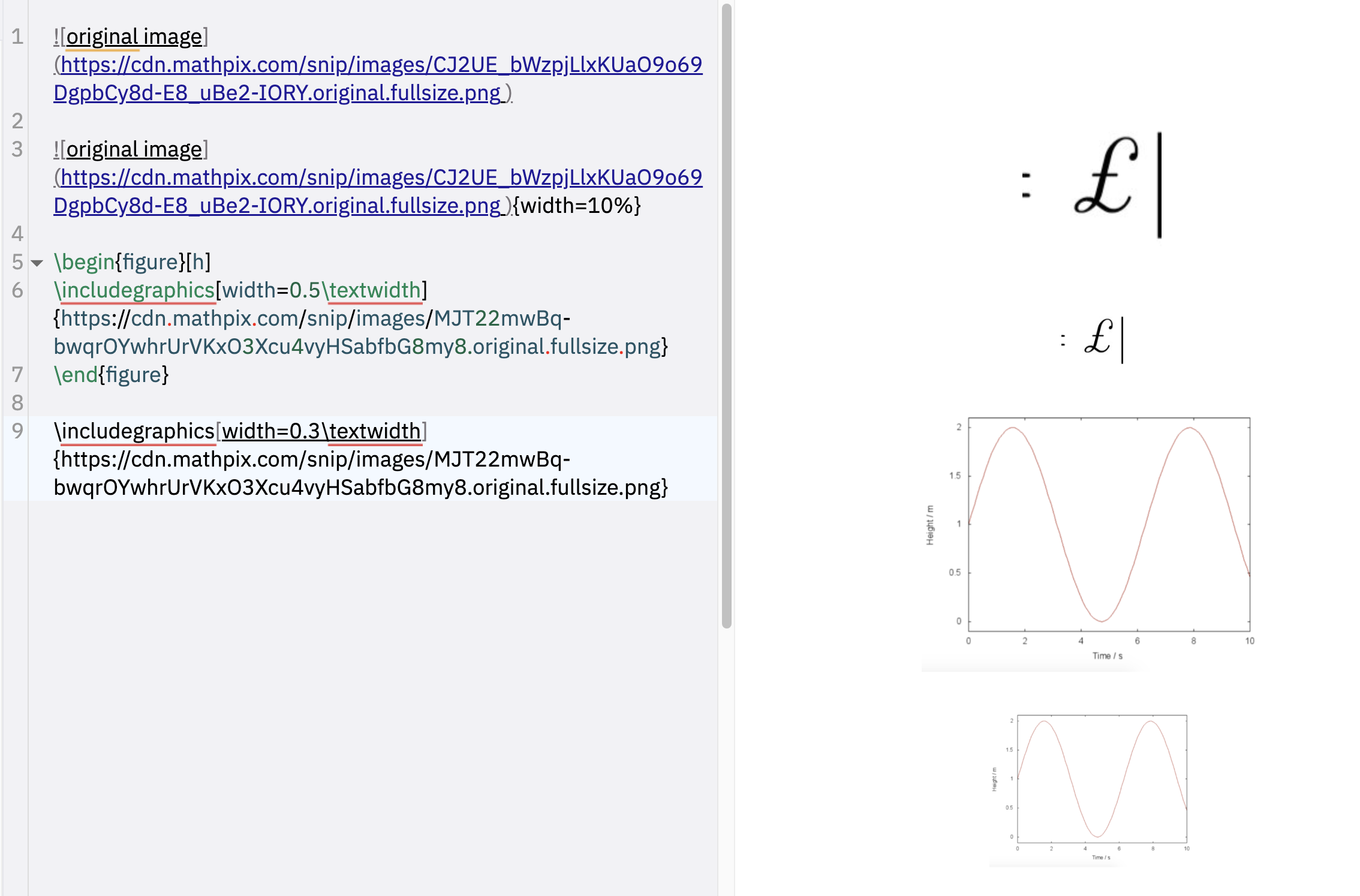Mathpix Markdown Syntax Reference
Inline math
Inline math can be represented using
$TeX$ or \( TeX \) delimiters.Examples:
Compute \(f(x) = x^2 + 2\) if \(x=2\).
Compute
Newton postulated that $\vec { F } = m \vec { a }$.
Newton postulated that
Block mode math (non-numbered)
Delimiters:
$$...$$Example LaTeX:
$$
x = \frac { - b \pm \sqrt { b ^ { 2 } - 4 a c } } { 2 a }
$$
Rendered equation:
Delimiters:
\[...\]Example LaTeX:
\[
y = \frac { \sum _ { i } w _ { i } y _ { i } } { \sum _ { i } w _ { i } } , i = 1,2 \ldots k
\]
Rendered equation:
Delimiters:
\begin{equation*}...\end{equation*}Example LaTeX:
\begin{equation*}
l ( \theta ) = \sum _ { i = 1 } ^ { m } \log p ( x , \theta )
\end{equation*}
Rendered equation:
Delimiters:
\begin{align*}...\end{align*}Example LaTeX:
\begin{align*}
t _ { 1 } + t _ { 2 } = \frac { ( 2 L / c ) \sqrt { 1 - u ^ { 2 } / c ^ { 2 } } } { 1 - u ^ { 2 } / c ^ { 2 } } = \frac { 2 L / c } { \sqrt { 1 - u ^ { 2 } / c ^ { 2 } } }
\end{align*}
Rendered equation:
Block mode math (numbered)
Delimiters:
\begin{equation}...\end{equation}Example LaTeX:
\begin{equation}
m = \frac { m _ { 0 } } { \sqrt { 1 - v ^ { 2 } / c ^ { 2 } } }
\end{equation}
Rendered equation:
Align, split, gather equation environments
Delimiters:
\begin{align}...\end{align}Example LaTeX:
\begin{align}
^{|\alpha|} \sqrt{x^{\alpha}} \leq(x \bullet \alpha) /|\alpha|
\end{align}
Rendered equation:
Delimiters:
Reason to use: split your equation into smaller pieces
\begin{split}...\end{split}Reason to use: split your equation into smaller pieces
Example LaTeX:
\begin{split}
a& =b+c-d\\
& \quad +e-f\\
& =g+h\\
& =i
\end{split}
Rendered equation:
- Use
\\to denote a new line and&to denote where the lines should align. - Need it numbered? Wrap it in
\begin{equation}...\end{equation}
Delimiters:
Reason to use: for displaying a set of consecutive equations that don’t require special alignment
\begin{gather}...\end{gather}Reason to use: for displaying a set of consecutive equations that don’t require special alignment
Example LaTeX:
\begin{gather}
a_1=b_1+c_1\\
a_2=b_2+c_2-d_2+e_2
\end{gather}
Rendered equation:
Delimiters:
Reason to use:
\begin{gather*}...\end{gather*}Reason to use:
gather environment without an equation numberExample LaTeX:
\begin{gather*}
a_1=b_1+c_1\\
a_2=b_2+c_2-d_2+e_2
\end{gather*}
Rendered equation:
Equation references
You can use
\label{}, \ref{} and \eqref{} to link to any numbered equation in your document:In equation \eqref{eq:1}, we find the value of an
interesting integral:
\begin{equation}
\int_0^\infty \frac{x^3}{e^x-1}\,dx = \frac{\pi^4}{15}
\label{eq:1}
\end{equation}
\begin{equation}
\| x + y \| \geq | \| x | | - \| y \| |
\label{eq:2}
\end{equation}
Look at the Equation \ref{eq:2}
In equation (5), we find the value of an
interesting integral:
interesting integral:
Look at the Equation 6
In addition to using numbered block mode equation syntax for standard numbering (i.e. 1, 2, 3), you can use also include
\tag{} inside of your LaTeX delimiters to create a custom tag. Note that if \tag{} is used in a numbered equation, it will override the document’s numbering.$$
\frac{x\left(x^{2 n}-x^{-2 n}\right)}{x^{2 n}+x^{-2 n}}
\tag{1.1}
$$
\begin{equation}
\max _{\theta} \mathbb{E}_{\mathbf{z} \sim \mathcal{Z}_{T}}\left[\sum_{t=1}^{T} \log p_{\theta}\left(x_{z_{t}} | \mathbf{x}_{\mathbf{z}_{<t}}\right)\right]
\tag{1.2}
\end{equation}
Chemical diagram formulas (SMILES)
Chemical formulas can be represented using SMILES syntax.
SMILES formulas can be rendered inline via
<smiles>OC(=O)c1cc(Cl)cs1</smiles> or block mode via:```smiles
OC(=O)c1cc(Cl)cs1
```
which renders as:
Titles, Sections, Abstracts (LaTeX)
| LaTeX syntax | Markdown equivalent | HTML equivalent |
\title{My Title} |
# My Title |
<h1 align="center">My Title</h1> |
\author{Author's Name} |
No equivalent | No equivalent |
\begin{abstract}...\end{abstract} |
No equivalent | No equivalent |
\section{Section Title} |
## Section Title |
<h2>Section Title</h2> |
\subsection{Section Title} |
### Section Title |
<h3>Section Title</h3> |
\subsubsection{Section Title} |
#### Section Title |
<h4>Section Title</h4> |
Note: The LaTeX
\title{} will always render center-aligned and an <h1>...</h1> HTML tag can be aligned using the align="..." attribute, but the Markdown title using # will always render left-aligned.Note: In Mathpix Markdown, You can use the
\title{} command wherever you want the title to appear in your document, as you would use the \maketitle command in a LaTeX document.Headings (Markdown)
| Markdown | HTML | Rendered output |
|---|---|---|
# H1 Heading |
<h1>H1 Heading</h1> |
H1 Heading |
## H2 Heading |
<h2>H2 Heading</h2> |
H2 Heading |
## H3 Heading |
<h3>H3 Heading</h3> |
H3 Heading |
## H4 Heading |
<h4>H4 Heading</h4> |
H4 Heading |
## H5 Heading |
<h5>H5 Heading</h5> |
H5 Heading |
## H6 Heading |
<h6>H6 Heading</h6> |
H6 Heading |
H1 Heading===== |
<h1>H1 Heading</h1> |
H1 Heading |
## H2 Heading---- |
<h2>H2 Heading</h2> |
H2 Heading |
Fonts (Markdown)
| Markdown | HTML | Rendered output |
|---|---|---|
**This is bold text** |
<b>This is bold text</b> |
This is bold text |
__This is also bold text__ |
<strong>This is bold text<strong> |
This is also bold text |
*This is italic text* |
<i>This is bold text</i> |
This is italic text |
_This is also italic text_ |
<em>This is bold text</em> |
This is also italic text |
~~Strikethrough~~ |
<s>Strikethrough</s> |
|
==This is marked text== |
<mark>This is marked text</mark> |
This is marked text |
Fonts (LaTeX)
| LaTeX syntax | Markdown equivalent | HTML equivalent |
\textit{italicized text} |
*italicized text* or _italicized text_ |
<i>italicized text</i> or <em>italicized text</em> |
\textbf{bold text} |
__bold text__ |
<b>bold text</b> or <strong>bold text</strong> |
\url{link} |
[link text](url) |
<a href="url">link text</a> |
Lists (Markdown)
Create an unordered list by starting a line with
+, -, or *+ Sub-lists are made by indenting 2 spaces:
- Different characters in in the same sub-list will render the same characters:
* Ac tristique libero volutpat at
+ Facilisis in pretium nisl aliquet
- Nulla volutpat aliquam velit
+ Very easy!
- Sub-lists are made by indenting 2 spaces:
- Different characters in in the same sub-list will render the same characters:
- Ac tristique libero volutpat at
- Facilisis in pretium nisl aliquet
- Nulla volutpat aliquam velit
- Different characters in in the same sub-list will render the same characters:
- Very easy!
Create an ordered list by writing 1,2,etc.
1. Lorem ipsum dolor sit amet
2. Consectetur adipiscing elit
3. Integer molestie lorem at massa
- Lorem ipsum dolor sit amet
- Consectetur adipiscing elit
- Integer molestie lorem at massa
1. You can use sequential numbers...
1. ...or keep all the numbers as 1 and it will automatically increment your list.
- You can use sequential numbers…
- …or keep all the numbers as 1.
Or start your list with any number and the numbering will continue:
57. foo
2. bar
6. foo
- foo
- bar
- foo
Lists (LaTeX)
You can also create lists using the LaTeX style
\begin{itemize} ... \end{itemize} environment.For example:
\begin{itemize}
\item One entry in the list
\item Another entry in the list
\end{itemize}
- •One entry in the list
- •Another entry in the list
You can read a full description of such lists here.
Hint
You can create a hint, which is a collapsible section, by using
+++ ... +++.For example:
+++ Click me...
Hello, world!
+++
Click me...
Hello, world!
Note that whatever text you want to be displayed next to the expand button should go on the same line as the first
+++.Code
Wrap inline code
in single backticks (`)…or wrap code blocks in three backticks (```) or three tildes (~~~)
var foo = function (bar) {
return bar++;
};
Include the programming language after the first three backticks or tildes for syntax highlighting:
var foo = function (bar) {
return bar++;
};
(All major languages supported via highlight.js.)
You can also create a code block by indenting all lines:
\\ some comments
line 1 of code
line 2 of code
line 3 of code
Will render:
\\ some comments
line 1 of code
line 2 of code
line 3 of code
Tables (Markdown)
Colons can be used to align columns:
| Tables | Are | Cool |
| :------------ |:-------------:| -----:|
| col 3 is | right-aligned | $1600 |
| col 2 is | centered | $12 |
| zebra stripes | are neat | $1 |
| Tables | Are | Cool |
|---|---|---|
| col 3 is | right-aligned | $1600 |
| col 2 is | centered | $12 |
| zebra stripes | are neat | $1 |
There must be at least 3 dashes separating each header cell.
The outer pipes (
The outer pipes (
|) are optional, and you don’t need to make the raw Markdown line up prettily:Markdown | Less | Pretty
--- | --- | ---
*Still* | `renders` | **nicely**
1 | 2 | 3
| Markdown | Less | Pretty |
|---|---|---|
| Still | renders |
nicely |
| 1 | 2 | 3 |
Tables (LaTeX)
The
tabular environment is a powerful and important LaTeX command that provides many options for table rendering and multi row / column spanning cells. The syntax looks as follows:\begin{tabular}{<<table spec>>} <<table content>> \end{tabular}
This example shows how to create a table in LaTeX.
\begin{tabular}{| l | l | l | l |}
\hline
Day & Min Temp & Max Temp & Summary \\ \hline
Monday & 11C & 22C & A clear day with lots of sunshine.
However, the strong breeze will bring down the temperatures. \\ \hline
Tuesday & 9C & 19C & Cloudy with rain, across many northern regions. Clear spells
across most of Scotland and Northern Ireland,
but rain reaching the far northwest. \\ \hline
Wednesday & 10C & 21C & Rain will still linger for the morning.
Conditions will improve by early afternoon and continue
throughout the evening. \\
\hline
\end{tabular}
| Day | Min Temp | Max Temp | Summary |
| Monday | 11C | 22C | A clear day with lots of sunshine. However, the strong breeze will bring down the temperatures. |
| Tuesday | 9C | 19C | Cloudy with rain, across many northern regions. Clear spells across most of Scotland and Northern Ireland, but rain reaching the far northwest. |
| Wednesday | 10C | 21C | Rain will still linger for the morning. Conditions will improve by early afternoon and continue throughout the evening. |
Read the full guide to LaTeX table support for more.
All tables in rendered HTML will be center aligned by default (unless other alignment method is set for those tables):

Quotes
Use a
> to write a blockquote like this:> This is my blockquote
This is my blockquote
> This is my blockquote,
> It's taking up two lines.
This is my blockquote,
It’s taking up two lines.
> This is my nested blockquote,
>> it's pretty nifty.
This is my nested blockquote,it’s pretty nifty.
Links
Use the
[Title](url) syntax to insert a link:[This is a link to the Mathpix website](http://mathpix.com/)
Images (Markdown)
Use the
 syntax to insert an image:

Include text in quotes after the url for a tooltip (hover over the image to see):


Parse and render additional parameters such as width, height, alignment:
{ width=50% }
{ width="36px" }
{width="20px",height="20px"}
{width="20px",height="20px",right}
{width="20px",height="20px", align="left"}

Images (LaTeX)
You can also insert images using LaTeX’s
figure environment.For example:
\begin{figure}[h]
\includegraphics[width=0.5\textwidth, center]{https://cdn.mathpix.com/snip/images/MJT22mwBq-bwqrOYwhrUrVKxO3Xcu4vyHSabfbG8my8.original.fullsize.png}
\end{figure}

You can read a full description of how to use here.
All images in rendered HTML will be center aligned by default (unless other alignment method is set for those images):

Footnotes
You can write footnotes either by writing out “first”, “second”, “third”, etc:
Footnote 1 link[^first]
Footnote 1 link[1]
Footnote reference[^second]
Footnote reference[2]
And you can reference the same footnote again like this:
My reference[^second]
My reference[2:1]
Or you can use numbers:
This is my next footnote[^3]
This is my next footnote[3]
You can reference multiple footnotes in a row[^3][^4]
You can also write inline footnotes:
Inline footnote^[Text of inline footnote] definition.
Inline footnote[5] definition.
Scroll to the bottom of the page to see how these footnotes render:
[^first]: Footnotes **can have markup**
and multiple paragraphs.
[^second]: Footnote text.
[^3]: Hello I am the third footote!
[^4]: And I'm the 4th!
Horizontal divider lines
Create horizontal rules like this:
___
---
***
Page Breaking
You can encourage page break by using
\pagebreak command. These page breaks are reflected when converting your document to LaTeX, PDF (with LaTeX), and DOCX formats.Misc.
Here are some other symbols supported:
(c) (C) (r) (R) (tm) (TM) (p) (P) +-
© © ® ® ™ ™ § § ±
Punctuation will get autocorrected:
test.. test... test..... test?..... test!....
test… test… test… test?.. test!..
!!!!!! ???? ,, -- ---
!!! ??? , – —
Emoji’s
Classic markup:
:wink: :cry: :laughing: :yum:
😉 😢 😆 😋
Shortcuts (emoticons):
:-) :-( 8-) ;)
😃 😦 😎 😉
Subscripts and Superscripts
19^th^
19th
H~2~O
H2O
Using HTML
You can also use HTML tags. Here is an example of a header:
<h2 style="color:blue;">This is a Blue Heading</h2>
This is a Blue Heading
You can also render SVGs!
<svg id="function random() { [native code] }" xmlns="http://www.w3.org/2000/svg" version="1.1" width="200px" height="150px" viewBox="0 0 200 150">\n\t<style> #function random() { [native code] } {pointer-events:none; } #function random() { [native code] } .event { pointer-events:all;} </style>\n\t<text x="136" y="79" font-family=" Helvetica" font-weight="900" font-size="14" fill="rgb(255,13,13)">O</text>\n\t<text x="115" y="43" font-family=" Helvetica" font-weight="900" font-size="14" fill="rgb(255,13,13)">O</text>\n\t<text x="126" y="43" font-family=" Helvetica" font-weight="900" font-size="14" fill="rgb(255,13,13)">H</text>\n\t<text x="73" y="42" font-family=" Helvetica" font-weight="900" font-size="14" fill="rgb(255,13,13)">O</text>\n\t<text x="84" y="42" font-family=" Helvetica" font-weight="900" font-size="14" fill="rgb(255,13,13)">H</text>\n\t<line x1="118" y1="64" x2="134" y2="72" style="stroke:rgb(0,0,0);stroke-width:1"/>\n\t<line x1="120" y1="60" x2="136" y2="69" style="stroke:rgb(0,0,0);stroke-width:1"/>\n\t<line x1="79" y1="63" x2="100" y2="75" style="stroke:rgb(0,0,0);stroke-width:1"/>\n\t<line x1="79" y1="67" x2="95" y2="76" style="stroke:rgb(0,0,0);stroke-width:1"/>\n\t<line x1="58" y1="99" x2="58" y2="74" style="stroke:rgb(0,0,0);stroke-width:1"/>\n\t<line x1="62" y1="96" x2="62" y2="77" style="stroke:rgb(0,0,0);stroke-width:1"/>\n\t<line x1="99" y1="99" x2="79" y2="111" style="stroke:rgb(0,0,0);stroke-width:1"/>\n\t<line x1="95" y1="97" x2="79" y2="106" style="stroke:rgb(0,0,0);stroke-width:1"/>\n\t<line x1="120" y1="46" x2="120" y2="63" style="stroke:rgb(0,0,0);stroke-width:1"/>\n\t<line x1="100" y1="75" x2="120" y2="63" style="stroke:rgb(0,0,0);stroke-width:1"/>\n\t<line x1="79" y1="45" x2="79" y2="63" style="stroke:rgb(0,0,0);stroke-width:1"/>\n\t<line x1="58" y1="74" x2="79" y2="63" style="stroke:rgb(0,0,0);stroke-width:1"/>\n\t<line x1="79" y1="111" x2="58" y2="99" style="stroke:rgb(0,0,0);stroke-width:1"/>\n\t<line x1="99" y1="99" x2="100" y2="75" style="stroke:rgb(0,0,0);stroke-width:1"/>\n\t<line id="function random() { [native code] }:Bond:1-0" class="event" x1="120" y1="63" x2="141" y2="75" stroke-width="8" stroke-opacity="0"/>\n\t<line id="function random() { [native code] }:Bond:4-3" class="event" x1="79" y1="63" x2="100" y2="75" stroke-width="8" stroke-opacity="0"/>\n\t<line id="function random() { [native code] }:Bond:7-6" class="event" x1="58" y1="99" x2="58" y2="74" stroke-width="8" stroke-opacity="0"/>\n\t<line id="function random() { [native code] }:Bond:9-8" class="event" x1="99" y1="99" x2="79" y2="111" stroke-width="8" stroke-opacity="0"/>\n\t<line id="function random() { [native code] }:Bond:2-1" class="event" x1="120" y1="39" x2="120" y2="63" stroke-width="8" stroke-opacity="0"/>\n\t<line id="function random() { [native code] }:Bond:3-1" class="event" x1="100" y1="75" x2="120" y2="63" stroke-width="8" stroke-opacity="0"/>\n\t<line id="function random() { [native code] }:Bond:5-4" class="event" x1="79" y1="38" x2="79" y2="63" stroke-width="8" stroke-opacity="0"/>\n\t<line id="function random() { [native code] }:Bond:6-4" class="event" x1="58" y1="74" x2="79" y2="63" stroke-width="8" stroke-opacity="0"/>\n\t<line id="function random() { [native code] }:Bond:8-7" class="event" x1="79" y1="111" x2="58" y2="99" stroke-width="8" stroke-opacity="0"/>\n\t<line id="function random() { [native code] }:Bond:9-3" class="event" x1="99" y1="99" x2="100" y2="75" stroke-width="8" stroke-opacity="0"/>\n\t<circle id="function random() { [native code] }:Atom:0" class="event" cx="141" cy="75" r="8" fill-opacity="0"/>\n\t<circle id="function random() { [native code] }:Atom:1" class="event" cx="120" cy="63" r="8" fill-opacity="0"/>\n\t<circle id="function random() { [native code] }:Atom:2" class="event" cx="120" cy="39" r="8" fill-opacity="0"/>\n\t<circle id="function random() { [native code] }:Atom:3" class="event" cx="100" cy="75" r="8" fill-opacity="0"/>\n\t<circle id="function random() { [native code] }:Atom:4" class="event" cx="79" cy="63" r="8" fill-opacity="0"/>\n\t<circle id="function random() { [native code] }:Atom:5" class="event" cx="79" cy="38" r="8" fill-opacity="0"/>\n\t<circle id="function random() { [native code] }:Atom:6" class="event" cx="58" cy="74" r="8" fill-opacity="0"/>\n\t<circle id="function random() { [native code] }:Atom:7" class="event" cx="58" cy="99" r="8" fill-opacity="0"/>\n\t<circle id="function random() { [native code] }:Atom:8" class="event" cx="79" cy="111" r="8" fill-opacity="0"/>\n\t<circle id="function random() { [native code] }:Atom:9" class="event" cx="99" cy="99" r="8" fill-opacity="0"/>\n</svg>